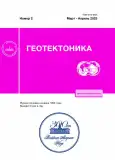No 2 (2023)
Articles
Localization of the Source of a Strong Historical Earthquake in Central Tuva Using Folklore-Historical and Paleoseismological Data
Abstract
The article presents the results of studies of the source of a strong earthquake in Central Tuva. The studies were carried out using both the widespread geological and geomorphological approach of paleo-seismological orientation, and the methods of historical seismology. Primary information about the source and its location was found in folklore sources with a toponymic reference, using which traces of the earthquake were found and mapped on the field. Traces of earthquakes are confirmed by seismic ruptures in the zone of the Ulugkhem active fault and secondary evidences. Preliminary dating of the event is 1715‒1758, magnitude Mw = 6.5‒7.0. The intensity of the earthquake at the epicenter reached VIII–IX (ESI-2007 scale). In the zone of the Ulugkhem active fault, the consequences of the catastrophic explosion of 1950, which led to human casualties and destruction, were mapped. The results of the research make it possible to clearly define the northern boundary of the Kyzyl intermountain basin as a fault with reverse-sinistral kinematics of displacements in the Holocene, and identification of the epicentral zone of a historical earthquake is necessary to assess the seismic hazard of the most densely populated region of Tyva Republic.
 3-24
3-24


Orenburg Radial-Concentric Structure at Great Depth: Experimental Modeling under Fluid Dynamic Loads and Comparative Analysis of Sandstone Samples from Oil Fields in Western Siberia
Abstract
The study of the deep structure of the Orenburg radial-concentric structure in the basement of the Russian Platform based on seismotectonic and geomorphological data has been carried out. Interpretation of temporal regional seismic profiles crossing the structure was performed, identifying the main deep faults and measuring their dip angles. It was revealed that the radial-concentric structure is a large flower structure. Its structure involves the main multidirectional deep faults dipping at angles of \(\perp \)60°–85° and limiting horst or reverse fault zones in the basement. The hierarchy of faults structure has been established. Oil and gas fields are confined to the main deep dislocations of the Orenburg structure and represent flower structures of minor sizes. An experimental modeling of the formation of “flower” structures was performed based on the analysis of the results of studies using data from the acoustic emission activity of rocks and under the action of fluid dynamic loads performed at the “UIK-AE” unit (Institute of Geophysics, Ural Branch of RAS, Russia) on sandstone core samples from reservoir rocks of oil fields in Western Siberia. The developed model showed that the formation of flower structures can occur without horizontal shear due to lateral compression and deep pressure. With the help of the seismo-acoustic emission method, characteristic noise was recorded during the formation of cracks in core samples, sound attenuation before splitting, and then its sharp explosive increase from a break in the continuity of the rock. Analysis of the core of wells drilled within the Orenburg radial-concentric structure revealed signs of hydrothermal fluid discharge in the sedimentary cover rocks, such as wavy (or flat) layering, bizarre textures and intervals of breccias, shell-shaped inclusions, stillotite seams, fluid textures. It is concluded that the genesis of the Orenburg radial-concentric structure is associated with the impact of deep heat flows, fluids, high pressure and has a commonality with the explosive ring structures of shields and platforms.
 25-38
25-38


Comparative Analysis of Gas-Geochemical Data from Ground-Based and Satellite Observations of the Sakhalin Island and Its Shelf (Northeast Russia): Tectonic Consequences
Abstract
The transitional zone of the marginal seas of the Asia‒Pacific region is a significant object for geological research, the large deposits of hydrocarbons (oil, gas, gas condensate, gas hydrates) have been discovered in the regions of the transition zone. The article gives an interpretation of the main gas-geochemical and geological-tectonic regularities of the occurrence and distribution of methane and carbon dioxide fields of different types on the shelf of Sakhalin Island. A study of the gas-geochemical parameters of the emitted gases in the “continent‒shelf” transit zone was carried out based on comparison of field studies and satellite observation data. The data of satellite observation of Sakhalin Island and its shelf are presented to identify the relationship between seismic events and changes in the level of methane concentration in the atmospheric air (in particular, on the example of the methane discharge regime of the Yuzhno-Sakhalinsky mud volcano). Remote sensing data are compared with the results of the field studies, and an assessment is made of the potential using satellite observation methods for studying the gas geochemical composition of the methane and carbon dioxide field. The results obtained can make it possible to refine the assessment of the emission of climatically active gases, and also bring the significant incentive to the development of the Russian Federation project “Far Eastern Marine Carbon Monitoring Plots Consortium”.
 39-56
39-56











